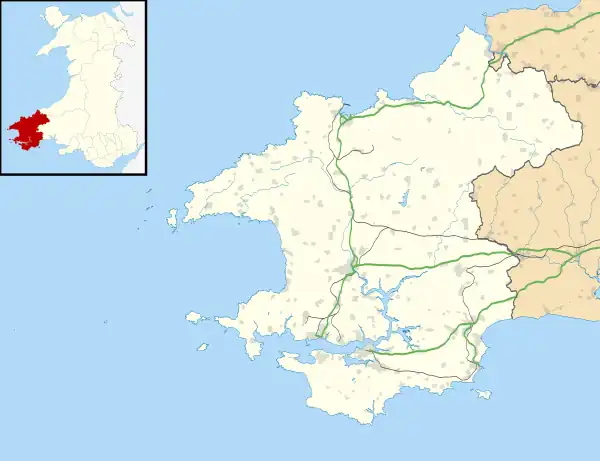| Scoveston | |
|---|---|
 Scoveston Location within Pembrokeshire | |
| OS grid reference | SN625515 |
| Community | |
| Principal area | |
| Preserved county | |
| Country | Wales |
| Sovereign state | United Kingdom |
| Post town | Haverfordwest |
| Postcode district | SA73 |
| Police | Dyfed-Powys |
| Fire | Mid and West Wales |
| Ambulance | Welsh |
| UK Parliament | |
| Senedd Cymru – Welsh Parliament | |
Scoveston is a small village near Llanstadwell and lies between Neyland and Steynton in the Welsh county of Pembrokeshire. Scoveston is a relatively new village, and the first recording of the name was in the 15th century. It is in the parish and community of Llanstadwell.[1]
History
The earliest-known record of Scoveston is from the 15th century, with some other settlements in the immediate area dating from the 16th to 18th centuries.[2] In 1644–45, Thomas Butler of Scoveston was High Sheriff of Pembrokeshire.[3] By 1863, the house had been rebuilt and was occupied by William Rees, another High Sheriff.[4] Scoveston and Upper Scoveston appear on a pre-1850 parish map of Llanstadwell,[5] but were not mentioned in 19th century gazetteers.[6]
Richard Fenton, in his 1811 Pembrokeshire tour, noted the mansion at Scoveston as being a venerable building transmuted into a farm-house, and having been owned by the Mordaunt family, one which was poorly documented.[7]
Upper Scoveston (also referred to as Scoveston Park or Scoveston Manor) was noted by the 1911 Royal Commission as including a boathouse, possible isolated geometric copses, sundial, well, walled garden and lake.[8]
On modern maps, the name is applied to the road passing through the settlement, as well as Upper Scoveston, Lower Scoveston, Middle Scoveston and Scoveston Grove.[1]
In 1985, Scoveston Manor was the scene of a double murder and extensive fire. John Cooper was later convicted of this and other crimes.[9][10] The following year, the house was sold and repurposed.[4]
See also
- Scoveston Fort - a Grade II Listed Building, which belongs to a series of forts built as part of the inner line of defence of the Haven.
References
- 1 2 "Ordnance Survey". Retrieved 4 July 2020.
- ↑ "Dyfed Archaeological Trust: Scoveston to Burton". Retrieved 4 July 2020.
- ↑ Nicholas, Thomas (1991). Annals and Antiquities of the Counties and County Families of Wales. ISBN 9780806313146. Retrieved 19 February 2011.
- 1 2 "RCAHMW: Scoveston, Upper" (PDF). Retrieved 4 July 2020.
- ↑ "GENUKI Parish map 105". Retrieved 4 July 2020.
- ↑ "GENUKI: Llanstadwell". Retrieved 4 July 2020.
- ↑ Fenton, Richard (1811). A historical tour through Pembrokeshire. London: Longman, Hurst, Rees, Orme & co. pp. 359–360.
- ↑ "Upper Scoveston, Garden, Milford Haven (265284)". Coflein. RCAHMW. Retrieved 29 September 2021.
- ↑ "John Cooper guilty of two Pembrokeshire double murders". BBC News. 26 May 2011. Retrieved 4 July 2020.
- ↑ "Double murders trial". Western Telegraph. 31 March 2011. Retrieved 4 July 2020.